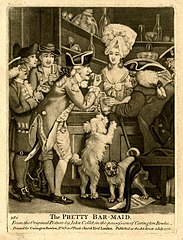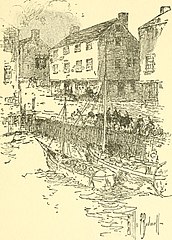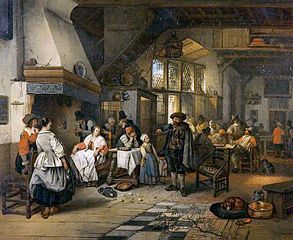
A quick research dive introduced to Mary Burke who kept a tavern in Saugus, Massachusetts. The advertisement she placed in the Columbian Centinel in April 1792 reminded customers that her house will be open every day in the week except the Sabbath…Larder will be consistently furnished with the choicest and most suitable provisions – her cellar with liquors of the best quality – her house with the best attendants she can procure – her stable with the best hay & Provender – the favor of her guests studied to be gained and always gratefully acknowledge.
Fresh Pond is 6 miles from Boston, the roads good & improving; the Pond well stored with fish, boats and all necessary fishing apparatus for ladies and gentlemen provided. Adjacent country furnishes game – and the walks in its vicinity are rurally agreeable.
Mary’s tavern was far enough out of Boston to be a destination for a spring or summer picnic. During the winter months, she accommodated sleighing parties. In addition, a tavern outside the city was the perfect place for courting couples to meet for dinner. Town watch patrols attempted to insure young men and women were not out walking together after 10:00 p.m., which seems to imply inappropriate behavior was less likely earlier in the evening.
The respectability of Mary Burke’s tavern and other establishments managed by women may be implied by the above 1778 illustration of the “Pretty Bar-Maid.” The young woman is surrounded by male admirers, but her clothing does not necessarily imply she sold more than alcoholic spirits.

I did my quick investigation of taverns so that one of my characters could meet a winsome lass who would be an inappropriate marriage partner, but a contender for his true affection. A sailor fresh in from the sea doubtless stopped at a wharf side tavern. Where better to meet a young woman with sparkling eyes?
The American Tavern
Taverns have a long history in America. The first tavern opened in Boston on March 4, 1634. Since the Puritans arrived in 1630, I suspect spirits were unofficially available from the time they set up the town. The illustration to the right depicts a tavern at the end of Long Wharf in Boston.
Taverns were a community resource. Workmen gathered in the mornings for a formal breakfast at 9:00. After 12:00, people came in for early card games and other entertainment before dinner was served at 2:00. Supper came out at 7:00.

Churchgoers came out of their unheated meeting house to get warm by the roaring fire at the tavern next door. Taverns hosted public meetings, court sessions, and provided a place to conduct business, read the newspapers, and catch up with news and gossip.
One of the most interesting aspects about taverns is that though the magistrates granted the business licenses to men, they expected the tavern would be run by a woman, usually the applicant’s wife or daughter.
Those gentlemen who please to favor me with their custom may depend upon genteel accommodations, and the very best entertainment. — Christiana Campbell, Virginia Gazette.
More on tavern entertainments and decor in the next installment.
🍺 🍺 🍺
Illustrations
The Pretty Bar-Maid, 1778.
Castle Tavern, Later George Tavern, at the end of Long Wharf, Boston.
Interior of Tavern by Jan August Hendrick Leys, 1844.
Steven Struzinski. “The Tavern in Colonial America.” The Gettysburg Journal. 2002.
Sarah Hand Meacham. “Keeping the Trade: The Persistence of Tavern-keeping among Middling Women in Colonial Virginia.” Early American Studies, Spring 2005. Vol 3, No 1. Pp 140-163

Sandra Wagner-Wright holds the doctoral degree in history and taught women’s and global history at the University of Hawai`i. Sandra travels for her research, most recently to Salem, Massachusetts, the setting of her new Salem Stories series. She also enjoys traveling for new experiences. Recent trips include Antarctica and a river cruise on the Rhine from Amsterdam to Basel.
Sandra particularly likes writing about strong women who make a difference. She lives in Hilo, Hawai`i with her family and writes a blog relating to history, travel, and the idiosyncrasies of life.

